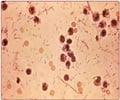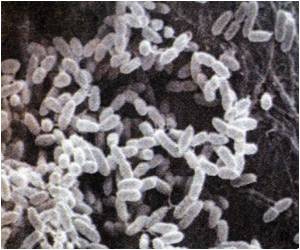How does the bacterium Shigelladetect that it's in a human host? Shigella is the cause of a deadly diarrheal disease.
How does the bacterium
Shigella detect that it's in a human host? Shigella is the cause of a deadly diarrheal disease. According to a study published May 21 in the journal
PLOS ONE, Ohio University scientists have found that a biological "RNA thermometer" monitors whether the environment is right for the bacterium to produce the factors it needs to survive within the body. The scientists have been seeking more information about the genetic pathways of
Shigella in the hope of finding new treatment options for the disease it causes.
Shigellosis kills more than a million people worldwide each year and is becoming more resistant to antibiotics, said Erin Murphy, an assistant professor in Ohio University's Heritage College of Osteopathic Medicine. The recent study led by Murphy and Andrew Kouse, a doctoral student in molecular and cellular biology, found that when
Shigella was in a 37 degree Celsius environment (or at "body temperature"), it efficiently produced the ShuA protein from the corresponding messenger RNA molecule. The bacterium needs the ShuA protein to obtain iron from heme, the most abundant source of this essential nutrient within the human body. Without iron, the invading
Shigella would not survive, Murphy explained.At room temperature, 25 degrees Celsius, production of the ShuA protein from the corresponding messenger RNA was inhibited. The scientists suggest that the structure of the RNA thermometer was blocking genetic expression by preventing protein synthesis.
"This may be an evolutionary adaptation, as it would be wasteful for the bacterium to make this protein before it was in the host," Murphy said. But once at body temperature, part of the structure of the thermometer "melts away," she said, triggering the bacterium to synthesize the ShuA protein.The new study marks the first time that researchers have observed a "RNA thermometer" in the
Shigella bacterium. This particular thermometer belongs to a subclass called "FourU RNA thermometers" that was first characterized by study co-author Franz Narberhaus of the Ruhr University Bochum, Germany. These thermometers have been identified in only two other bacteria, Salmonella and Yersinia, both of which can cause serious human illnesses.
"I find it fascinating that an entirely new class of genes has been found to be controlled by an RNA thermometer," Narberhaus said. Now that the scientists have identified the RNA thermometer in the ShuA gene, they'll look for this structure in the other genes that regulate
Shigella's ability to survive in the human host and cause disease."The findings could have practical implications for drug design," Murphy said.
Source-Eurekalert

 MEDINDIA
MEDINDIA



 Email
Email




